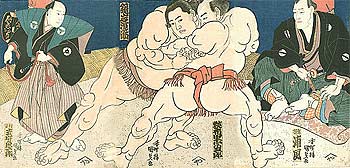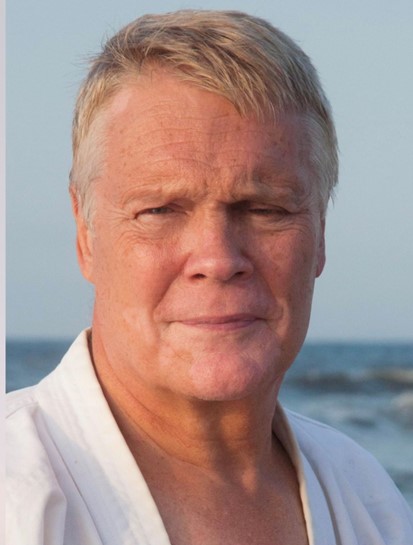The Tear Over Sumo Pants
By Christopher Caile

Many young Japanese consider it immodest and non-stylish to wear sumo’s traditional loin cloth which leaves the buttocks exposed. It is thought that this has contributed to the decline of the art among youthful participants.
3/28/05. Japanese sumo is in middle of a major tussle. Contestants aren’t the gargantuan wrestlers you would expect, but conservative tradition-bound elements versus amateur factions, the latter seeking to boost the sports appeal among youngsters. The fight is over one of sumo’s most famous symbols: the loincloth, known as mawashi, which contestants wear around their broad naked midquarters.
The controversy made the front page of Yomiuri, Japan’s best selling newspaper, on March 24, 2005.


Front of rear views of the proposed amateur sumo pants worn under the traditional mawashi, loin cloth.
Faced with declining participation amongst kids, the Japanese Amateur Sumo Federation voted to allow athletes to wear more modest “sumo pants” under the traditional mawashi. The amateurs believe young Japanese men avoid the sport because of the loincloths, which leaves participants feeling uncomfortably exposed as they crouch down, buttocks facing one another over the clay of the sumo ring known as dohyo.
Its vice-chairman, Hidetoshi Tanaka, stated that, “In this age, young people on school holiday wear swimsuits in public baths. It is understandable that many would not want to wear the mawashi on its own.”
Yomiuri quoted on amateur sumo official as saying, “Pubescent kids are not going to want to take part if they don’t look cool.”
Amongst the Sumo community there is concern about the long term future of the sport faced with declining membership among younger Japanese and a national sports audience seemingly more attracted to non-indigenous sports, such as baseball and football. In 2005 only 70 new professional wrestlers were admitted to the sport compared to twice that number in the early 1990’s.
But the Professional Japan Sumo Association, the Nihon Sumo Kyokai, strong objected, refusing to allow youth tournament participants to wear the proposed pant at the sport’s most prestigious location, the Hall of the National Pursuit in the Ryogoku district of Tokyo. There the clay of the ring (dohyo) is considered a sacred spot. Women are not allowed to set foot on it. And the association that male wrestlers can’t either if they wear the modest pants.
Yomiuri quoted a Professional Japan Sumo Association spokesman who stated, “The national stadium has its rules and ways of doing things. We have no intention of allowing children in pants into the ring.”
This is not new. During last year’s high school national championships in this hall, contestants who wore pants were compelled to remove them.
The proposed “sumo pants” are a tight, thigh-length garment, which cover the wrestler’s buttocks as they crouch down to face one another in the ring.
Manufacturers of sumo pants state that they are suitable for Japanese sumo classes at elementary, junior, and senior high schools, as well as universities. They were designed for both sexes and can be worn over undergarments, with the mawashi on top, so multiple participants can use the pants. They also allow provide tournament efficiency since they can be reused in subsequent tournaments.
About the Author Christopher Caile

Christopher Caile
Christopher Caile is the Founder and Editor-In-Chief of FightingArts.com. He has been a student of the martial arts for over 65 years.
He first started in judo while in college. Then he added karate as a student of Phil Koeppel in 1959 studying Kempo and Wado-Ryu karate. He later added Shotokan Karate where he was promoted to brown belt and taught beginner classes. In 1960 while living in Finland, Caile introduced karate to that country and placed fourth in that nation’s first national judo tournament.
Wanting to further his karate studies, Caile then hitch hiked from Finland to Japan traveling through Scandinavia, Europe, North Africa, the Middle East and South and Southeast Asia — living on 25 cents a day and often sleeping outside.
Arriving in Japan (1962), Caile was introduced to Mas Oyama and his fledgling full contact Kyokushinkai Karate by Donn Draeger, the famous martial artist and historian. Donn also housed him with several other senior international judo practitioners. Donn became Caile’s martial arts mentor, coaching him in judo and introducing him to Shinto Muso-ryu under Takaji Shimizu.
Caile studied at Oyama’s honbu dojo and also at Kenji Kurosaki’s second Tokyo Kyokushinkai dojo. In his first day in class Oyama asked Caile to teach English to his chief instructor, Tadashi Nakamura. They have been friends ever since. Caile also participated in Oyama’s masterwork book, “This Is Karate.”
Caile left Japan with his black belt and designation as Branch Chief, the first in the US to have had extensive training in Japan directly under Oyama Sensei. As such, Oyama Sensei asked him to be his representative on visits to his US dojos to report on their status.
A little over a year later, Nakamura, Kusosaki and Akio Fujihira won an epic David vs. Goliath challenge match against Thailand’s professional Muay Thai Boxers in Bangkok, Thailand, thrusting Kyolushinkai and Nakamura into national prominence.
Back in the US Caile taught Kyokushinkai karate in Peoria, Il while in college and later in Washington, DC. while in graduate school. Durimg this time Shihan Nakamura had moved to New York City to head Kyokushinkai’s North American Operation.
In 1976 when Kaicho Tadashi Nakamura formed the World Seido Karate organization, Caile followed. Living then in Buffalo, NY, Caile taught Seido karate and self-defense at the State University of New York at Buffalo (SUNY Buffalo) for over 15 years where he also frequently lectured on martial arts and Zen in courses on Japanese culture.
Caile moved to New York City in 1999 to marry Jackie Veit. He is now an 8th degree black belt, Hanshi, training in Seido Karate’s Westchester, NY Johshin Honzan (Spiritual Center) dojo. In Seido Caile is known for his teaching of and seminars on kata applications. He also produced a 14 segment video series on Pinan kata Bunkai currently available to Seido members.
Caile is also a long-time student and Shihan in Aikido. He studied in Buffalo, under Mike Hawley Shihan, and then under Wadokai Aikido’s founder, the late Roy Suenaka (uchi deshi under Morihei Ueshiba, founder of Aikido and was Shihan under Tohei Sensei). In karate, Suenaka (8thdan) was also an in-house student of the Okinawan karate master Hohan Soken.
Having moved to New York City, Caile in 2000 founded this martial arts educational website, FightingArts.com. Twenty-five years later, in 2025, it underwent a major update and revision.
For FightingArts.com and other publications Caile wrote hundreds of articles on karate, martial arts, Japanese art, Chinese Medicine and edited a book on Zen. He also developed relationships with a cross section of leading martial arts teachers. Over the last four decades he has conducted extensive private research into karate and martial arts including private translations of the once secret Okinawan hand copied and passed on Kung Fu book, the Bubishi, as well as an early karate book by the karate master Kenwa Mabuni. He periodically returns to Japan and Okinawa to continue his studies and participate Seido karate events. In Tokyo he practiced (with Roy Suenaka Sensei) in a variety of aikido organizations with their founders – including private interviews and practices at the Aiki-kai Aikido Honbu dojo with the son and grandson of aikido’s founder, Doshu (headmaster) Kisshomaru (an old uchi-deshi friend) and his son, Moriteru Ueshiba and in Iwama with Morihiro Saito. On Okinawa he studied Goju Ryu karate under Eiichi Miyazato, 10th dan founder of Naha’s Jundokan, and also with Yoshitaka Taira (who later formed his own organization, who specialized in kata Bunkai. While there Caile also trained with Hohan Soken’s senior student, Master Fusei Kise, 10 dan as well as with the grandson of the legendary karate master Anko Itosu.
Caile’s other martial arts experience includes: Diato-ryu Aikijujitsu and Kenjitsu, kobudo, boxing, Muay Thai, MMA, Kali (empty hand, knife and bolo), study of old Okinawan Shoran-ryu & Tomari body mechanics, study of old Okinawan kata under Richard Kim, study of close quarter defense and combat, including knife and gun defenses, Kyusho Jitsu and several Chinese fighting arts including 8 Star Praying Mantis, Pak Mei (White Eyebrow), and a private family system of Kung Fu.
Caile is also a student of Zen as well as a long-term student of one branch of Traditional Chinese Medicine, Chi Kung (Qigong). As one of two senior disciples of Chi Kung master Dr. Shen (M.D., Ph.D.) Caile was certified to teach and practice. This led to Caile’s founding of the The Chi Kung Healing Institute on Grand Island, NY. In Western NY, he also frequently held Chi Kung seminars, including at SUNY Buffalo and at the famous Chautauqua Institution in Chautauqua, NY. His articles on Chi Kung also appeared in the Holistic Health Journal and in several books on alternative medicine.
Caile holds a BA in International Studies from Bradley University and MA in International Relations with a specialty in South and Southeast Asia from American University in Washington, D.C. While in Buffalo, NY he also studied digital and analog electronics.
In his professional life Caile also worked in public relations and as a newspaper reporter and photographer. Earlier he worked in the field of telecommunications including Managing a Buffalo, NY sales and service branch for ITT. He then founded his own private telephone company. This was followed by creation of an electrical engineering company that designed and patented his concept for a new type of low-cost small business telephone system (which was eventually sold to Bell South). The company also did contract work for Kodak and the US space program. Simultaneously Caile designed and manufactured a unique break-apart portable pontoon boat.
Most recently Caile co-founded an internet software company. Its products include software suites with AI capability for control and management of streaming media, such as video and music, an all-in-one book publishing software product for hardcover, eBook and audio book creation and security software for buildings and government use.
For more details about Christopher Caile’s martial arts, work experience and life profile, see the About section in the footer of this site.
Search for more articles by this author:






